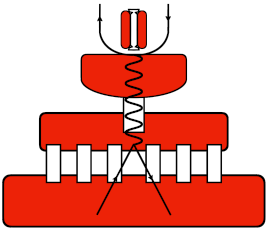Speaker
Description
Spin correlations for the $\Lambda \Lambda$ and $\Lambda \bar{\Lambda}$ pairs, produced in relativistic heavy-ion collisions, and related angular correlations at the joint registration of space-parity nonconserving hadronic decays
of two hyperons are theoretically analyzed. These correlations give important information about the character and mechanism of multiple processes, and the advantage of the
$\Lambda \Lambda$ and $\Lambda \bar{\Lambda}$ systems over other ones is conditioned by the fact that the $P$-odd decays $\Lambda \rightarrow p + \pi^-$ and
$\bar{\Lambda} \rightarrow \bar{p} + \pi^+$ serve as effective analyzers of spin states of the $\Lambda$ and $\bar{\Lambda}$ particles -- thus, the respective spin correlations can be
rather easily distinguished and studied experimentally, which is especially important for studies of multiple particle generation at modern and future ion colliders ( RHIC, LHC, NICA ). The correlation tensor components can be derived by the method of "moments" -- as a result of averaging the combinations of
trigonometric functions of proton (antiproton ) flight angles over the double angular distribution of flight directions for
products of two decays. The properties of the "trace" $T$ of the correlation tensor ( a sum of three diagonal components ),
which determines the angular correlations as well as the relative fractions of the triplet and singlet states of respective pairs, are discussed.
In this report, spin correlations for two identical ($\Lambda \Lambda$) and two non-identical ($\Lambda \bar{\Lambda}$) particles are generally considered within the conventional model of one-particle sources, implying that correlations vanish at
enough large relative momenta. However, under these conditions (especially at
ultrarelativistic energies), for two non-identical particles ($\Lambda \bar{\Lambda}$) the two-particle -- quark-antiquark and two-gluon -- annihilation sources start playing a noticeable role and lead to the difference of the correlation tensor from zero. In particular, such a situation may arise, when the system
passes through the "mixed phase" and -- due to the multiple production of free quarks and gluons in the process of deconfinement
of hadronic matter -- the number of two-particle sources strongly increases.




